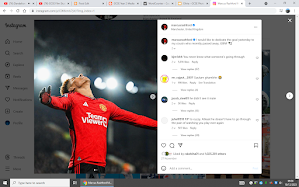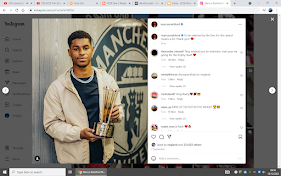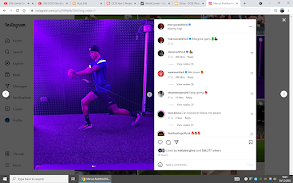Language
1) Make two lists - one of the website conventions used on Marcus Rashford's official website and one of the social media conventions found on Rashford's Twitter or Instagram pages.
2) How does his website promote the Marcus Rashford brand?
Marcus Rashford has created a strong personal brand that merges different genres – footballer, campaigner / activist, influencer and celebrity. He has been praised for his high-profile campaigns on food poverty (putting pressure on the government to provide free school meals in holidays during Covid-19) as well as homelessness and books for children.
3) What connotations can be be found in the homepage for Marcus Rashford's website (you can mention either the old or new homepage)?
Sophistication, smart, professional
4) How does Marcus Rashford use his social media profiles to promote his brand and campaigns? Give at least three examples of different posts / images / design from his social media.
Posts about football, charity work, twitter posts
5) How does Marcus Rashford's online presence use the narrative of his childhood upbringing to create a positive brand identity?
2) Marcus Rashford’s online presence is partly driven by his excellent use of social media. How does he use social media to engage with his fans and make them feel part of his brand?
He posts on Instagram and Twitter. He creates a close connection with them by posting relatable things others may like, like football.
3) What is Marcus Rashford's Instagram engagement rate and what does this tell us?
6% This means his engagement is very high which is good.
4) Go to Marcus Rashford's Twitter or Instagram account. Find and screenshot/link four tweets/posts that show the different aspects of his brand e.g. Relatable person (normal, down to earth), Campaigner (interested in politics), Celebrity footballer (e.g. awards ceremony or fashion).




5) What audience pleasures are provided by Marcus Rashford's online presence? Try and apply Blumler and Katz's Uses and Gratifications theory here.
Personal relationships
6) Applying Stuart Hall's Reception theory, what would a preferred and oppositional reading of Marcus Rashford's online presence be?
Preferred: Good person, helpful
2) What charities and companies/brands is Marcus Rashford associated with? Why might they want to be linked to the Rashford brand?
5) How do social media platforms manage online abuse on their platforms and why has Marcus Rashford drawn attention to this? How might this change in the future?
He has spoken about it in Sky News.
6) What happened by law in 2022 that changed the way the internet is regulated? Write three changes that this new law may bring in and explain why it is difficult to regulate the internet.
1) Make two lists - one of the website conventions used on Marcus Rashford's official website and one of the social media conventions found on Rashford's Twitter or Instagram pages.
Website conventions
Website key conventions include:
- Logo/brand identity
- Navigation – menus
- Central image
- Multimedia features – e.g. video
- Social media links/integration
Social media conventions
Social media key conventions include:
- Logo/brand identity
- Bio (personal details/information)
- Profile image
- Background/banner image
- Images and video
- Online engagement/audience interaction
Marcus Rashford has created a strong personal brand that merges different genres – footballer, campaigner / activist, influencer and celebrity. He has been praised for his high-profile campaigns on food poverty (putting pressure on the government to provide free school meals in holidays during Covid-19) as well as homelessness and books for children.
3) What connotations can be be found in the homepage for Marcus Rashford's website (you can mention either the old or new homepage)?
Sophistication, smart, professional
4) How does Marcus Rashford use his social media profiles to promote his brand and campaigns? Give at least three examples of different posts / images / design from his social media.
Posts about football, charity work, twitter posts
5) How does Marcus Rashford's online presence use the narrative of his childhood upbringing to create a positive brand identity?
His online presence – particularly video content – emphasises his working class background, how hard his mum worked as a single parent and his own positive attitude towards hard work.
Representations
1) How does Rashford use different aspects of mise-en-scene (e.g. clothes/costume) to create very different representations of himself on his own website?
Representations
1) How does Rashford use different aspects of mise-en-scene (e.g. clothes/costume) to create very different representations of himself on his own website?
He wears smart clothes (suit). But then he also wears a football kit.
2) What representations of football or footballers can you find in Marcus Rashford's online presence? Does it reinforce or subvert traditional stereotypes of footballers?
It subverts stereotypes as many footballers don't do charity work or maybe don't post about it.
3) What examples can you find of website pages, social media posts or aspects of the brand that create a positive representation of Marcus Rashford? You may wish to comment on his discussion of family or his campaigns - his page on the FareShare campaign website may help with this question.
Charity work with Fareshare.
4) What representations of masculinity can you find in Marcus Rashford's online presence? Does this reinforce or challenge traditional gender stereotypes?
2) What representations of football or footballers can you find in Marcus Rashford's online presence? Does it reinforce or subvert traditional stereotypes of footballers?
It subverts stereotypes as many footballers don't do charity work or maybe don't post about it.
3) What examples can you find of website pages, social media posts or aspects of the brand that create a positive representation of Marcus Rashford? You may wish to comment on his discussion of family or his campaigns - his page on the FareShare campaign website may help with this question.
Charity work with Fareshare.
4) What representations of masculinity can you find in Marcus Rashford's online presence? Does this reinforce or challenge traditional gender stereotypes?
Marcus Rashford’s online presence offers a real mix of representations – some reinforcing stereotypes of masculinity, footballers and race/ethnicity but at other points subverting them.
5) What representations of race/ethnicity can you find in his website or social media? Does this reinforce or challenge media stereotypes?
He looks to challenge stereotypes regarding poverty, age, people receiving benefits and social class.
Audience
1) Who are the potential target audiences for Marcus Rashford's online content? Try and cover both demographics and psychographics.
Boys, footballers, teenagers
5) What representations of race/ethnicity can you find in his website or social media? Does this reinforce or challenge media stereotypes?
He looks to challenge stereotypes regarding poverty, age, people receiving benefits and social class.
Audience
1) Who are the potential target audiences for Marcus Rashford's online content? Try and cover both demographics and psychographics.
Boys, footballers, teenagers
2) Marcus Rashford’s online presence is partly driven by his excellent use of social media. How does he use social media to engage with his fans and make them feel part of his brand?
He posts on Instagram and Twitter. He creates a close connection with them by posting relatable things others may like, like football.
3) What is Marcus Rashford's Instagram engagement rate and what does this tell us?
6% This means his engagement is very high which is good.
4) Go to Marcus Rashford's Twitter or Instagram account. Find and screenshot/link four tweets/posts that show the different aspects of his brand e.g. Relatable person (normal, down to earth), Campaigner (interested in politics), Celebrity footballer (e.g. awards ceremony or fashion).
5) What audience pleasures are provided by Marcus Rashford's online presence? Try and apply Blumler and Katz's Uses and Gratifications theory here.
Personal relationships
6) Applying Stuart Hall's Reception theory, what would a preferred and oppositional reading of Marcus Rashford's online presence be?
Preferred: Good person, helpful
Oppositional: boastful, lucky, showing off
Preferred reading (people who support Marcus Rashford):
Oppositional reading (people who criticise Marcus Rashford):
Industry
1) What is Marcus Rashford's net worth and how does his online presence help him to make money?
£16million. He has additional deals with Burberry, BT Sport (now TNT Sport), Coca-Cola and others
Preferred reading (people who support Marcus Rashford):
Oppositional reading (people who criticise Marcus Rashford):
Industry
1) What is Marcus Rashford's net worth and how does his online presence help him to make money?
£16million. He has additional deals with Burberry, BT Sport (now TNT Sport), Coca-Cola and others
2) What charities and companies/brands is Marcus Rashford associated with? Why might they want to be linked to the Rashford brand?
Burberry, BT Sport (now TNT Sport), Coca-Cola, Fareshare and others.
3) Research Twitter and Instagram. Who owns the companies, how do they make money and how much profit did they make last year?
3) Research Twitter and Instagram. Who owns the companies, how do they make money and how much profit did they make last year?
Twitter: $4.4billion. Owned by Elon Musk.
Instagram: $51.4billion. Owned by Meta
4) What are the worries about Instagram’s negative effects?
Cyberbullying, catfishing, addiction to social media
4) What are the worries about Instagram’s negative effects?
Cyberbullying, catfishing, addiction to social media
5) How do social media platforms manage online abuse on their platforms and why has Marcus Rashford drawn attention to this? How might this change in the future?
He has spoken about it in Sky News.
6) What happened by law in 2022 that changed the way the internet is regulated? Write three changes that this new law may bring in and explain why it is difficult to regulate the internet.
- Sending threatening posts being punishable by jail sentences.
- Platforms like Twitter and Instagram having to actively prevent users seeing harmful material – or risk being fined by Ofcom.
- Platforms paying Ofcom to regulate their content.
Comments
Post a Comment